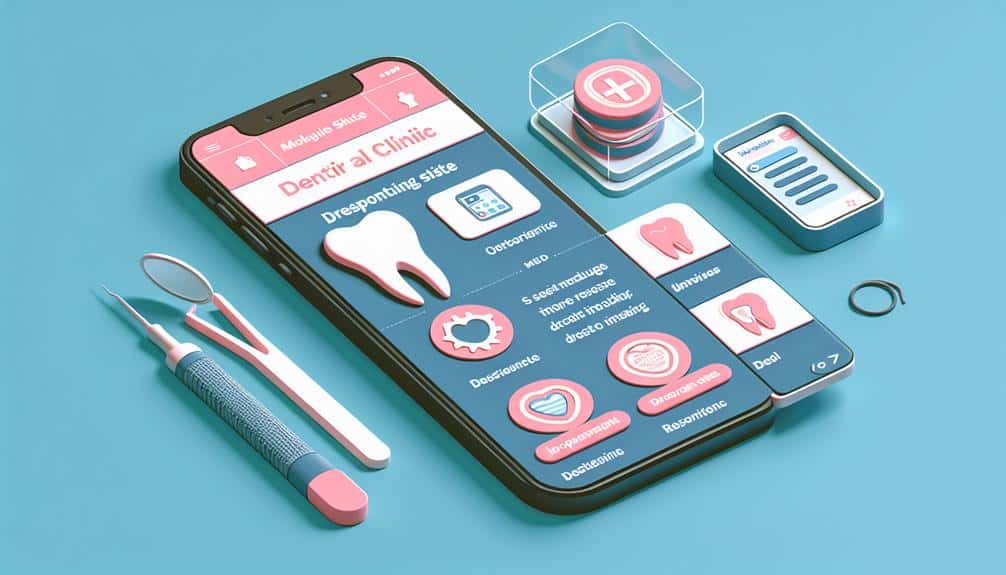Are you tired of potential patients bouncing off your dental website because it takes forever to load on their mobile devices?
Well, fret not, because there are ways you can optimize your site for mobile SEO and ensure a seamless user experience.
From understanding the importance of mobile-friendly website design to implementing responsive design and leveraging local mobile SEO strategies, there are various techniques dentists can employ to attract and retain patients on their mobile platforms.
So, if you’re ready to take your dental practice to new heights and stay ahead of the competition, keep reading to discover the secrets of optimizing your site for mobile SEO.
Key Takeaways
- Prioritize responsive design to ensure that the website is easily accessible and user-friendly on mobile devices.
- Optimize website loading speed by minimizing file sizes, using caching techniques, and optimizing images.
- Enhance mobile site performance by minifying CSS and JavaScript, enabling browser caching, and reducing redirects.
- Create mobile-friendly content by using clear and concise language, optimizing metadata and headings, and including location-specific keywords for local search.
Why Mobile SEO Is Essential for Dentists
Mobile SEO is crucial for dentists to ensure they can reach and engage with their patients effectively in today’s digital age. With the increasing use of smartphones and tablets, more and more people are relying on their mobile devices to search for information, including finding a dentist. By optimizing their websites for mobile SEO, dentists can benefit from increased visibility and improved user experience, ultimately attracting more patients.
One of the key benefits of mobile SEO for dentists is the ability to reach a larger audience. As mobile devices have become an integral part of people’s lives, it’s essential for dentists to have a mobile-friendly website that’s easily accessible and navigable on smartphones and tablets. By doing so, they can tap into the growing number of mobile users searching for dental services.
Understanding mobile user behavior is another important aspect of mobile SEO for dentists. Mobile users tend to have different search patterns and preferences compared to desktop users. They often search for local services, including dentists, while on the go. Dentists who optimize their websites for mobile SEO can take advantage of this behavior by ensuring their websites are optimized for local search and providing relevant and easily accessible information such as contact details, location, and appointment booking.
Understanding Mobile-Friendly Website Design
To ensure your website is mobile-friendly, it’s important to prioritize responsive design. This means designing your website in a way that allows it to adapt and function properly across different devices, such as smartphones and tablets. Here are some key points to keep in mind when it comes to mobile-friendly website design:
- Mobile-friendly navigation:
- Simplify your navigation menu: Use dropdown menus or collapsible sections to make it easier for users to navigate your site on smaller screens.
- Place important information at the top: Mobile users often have limited screen space, so make sure to prioritize the most important content and contact information.
- Mobile site optimization:
- Optimize page load times: Mobile users expect fast loading times, so optimize your website’s performance by compressing images, minifying code, and using caching techniques.
- Use the right fonts and font sizes: Ensure that your text is legible on small screens by using clear fonts and appropriate font sizes.
Optimizing Website Loading Speed for Mobile Users
To optimize your website loading speed for mobile users, there are several key points to consider.
First, you need to speed up the mobile loading process by minimizing the size of your website’s files and using caching techniques.
Second, improving your page load time is crucial to ensure a smooth user experience and prevent potential bounce rates.
Lastly, enhancing your mobile site’s performance can be achieved by optimizing images, reducing redirects, and utilizing a content delivery network (CDN) to deliver your website’s content more efficiently.
Speed up Mobile Loading
By optimizing your website’s loading speed for mobile users, you can significantly enhance their browsing experience and boost your overall online performance. Improving user experience and reducing bounce rate are crucial factors in attracting and retaining visitors to your dental website.
To speed up mobile loading, consider implementing the following strategies:
- Optimize images: Compress images to reduce file size without compromising quality. Use responsive images that adapt to different screen sizes.
- Minify code: Remove unnecessary spaces, comments, and formatting from your website’s code. This reduces file size and improves loading speed.
- Enable browser caching: Utilize browser caching to store static resources like images, CSS, and JavaScript files. This allows returning visitors to load your site faster.
- Use a content delivery network (CDN): A CDN stores your website’s files on servers distributed worldwide, enabling faster access for users from different locations.
Implementing these measures will ensure that your dental website loads quickly on mobile devices, providing a smooth and enjoyable browsing experience for your visitors.
Improve Page Load Time
As you focus on improving your dental website’s loading speed for mobile users, consider implementing strategies to optimize your page load time.
One effective strategy is to increase site responsiveness. This involves optimizing your website’s code and structure to ensure that it loads quickly and smoothly on mobile devices. By minimizing unnecessary code and reducing the number of HTTP requests, you can significantly improve the loading speed of your website.
Another important factor to consider is the size of your images. Large image files can slow down your website’s loading speed, so it’s crucial to optimize them by compressing and resizing them without sacrificing quality.
Enhance Mobile Site Performance
Improve the loading speed of your dental website for mobile users by enhancing mobile site performance. A slow-loading website can lead to frustrated users and higher bounce rates. To optimize your mobile site design and improve its performance, consider the following:
- Optimize images: Compress and resize images to reduce file size without sacrificing quality.
- Minify CSS and JavaScript: Remove unnecessary characters and spaces to reduce file size.
- Enable browser caching: Store static files, such as images and scripts, in the user’s browser cache to reduce server load and load times.
- Use a content delivery network (CDN): Deliver website content from servers closer to the user’s location, reducing latency.
- Reduce redirects: Minimize the number of redirects as they can slow down page loading.
Implementing Responsive Design for a Seamless User Experience
To create a seamless user experience, dentists should consider implementing responsive design on their mobile websites. Responsive design ensures that your website adapts to different screen sizes and devices, providing a consistent and user-friendly experience for your patients. Here are some responsive design tips and mobile SEO best practices to help you optimize your dental website:
| Responsive Design Tips | Mobile SEO Best Practices |
| Use a mobile-friendly layout with clear navigation | Optimize your website for speed and performance |
| Ensure that your content is easily readable on small screens | Use responsive images to improve load times |
| Use a responsive font size that adjusts to different screen sizes | Optimize your metadata and headings for mobile search |
| Implement touch-friendly buttons and forms | Optimize your site for local search by including location-specific keywords |
| Test your website on different devices and screen sizes | Ensure that your website is mobile-friendly by using Google’s Mobile-Friendly Test |
Mobile-Friendly Content Creation for Dental Websites
Create mobile-friendly content for your dental website to enhance the user experience and improve your mobile SEO rankings. When optimizing your content for mobile users, keep in mind the principles of mobile-first design and focus on providing a seamless experience across different devices.
Here are some key strategies to consider:
- Simplify your content: Break down complex information into bite-sized pieces that are easy to read and digest on a smaller screen. Use headings, subheadings, and bullet points to make your content scannable and accessible.
- Use responsive images: Optimize your images for mobile by reducing their file size and ensuring they load quickly. Consider using responsive image techniques to ensure they display properly on different screen sizes.
- Prioritize page speed: Mobile users expect fast-loading websites. Compress your website’s assets, minimize code, and leverage browser caching to improve your page speed. This won’t only improve the user experience but also positively impact your mobile SEO rankings.
- Implement click-to-call functionality: Make it easy for mobile users to contact your dental practice by adding click-to-call buttons. This feature allows users to call your office directly from their mobile devices with just one tap.
- Incorporate mobile-friendly forms: Optimize your contact forms and appointment booking forms for mobile users. Simplify the form fields, use autofill options, and ensure that the forms are easy to navigate and submit on smaller screens.
Leveraging Local Mobile SEO Strategies
To optimize your dental practice’s online visibility, you need to focus on location-based SEO tactics. This means incorporating keywords that include your city or region into your website content, meta tags, and URLs.
Additionally, make sure your website is mobile-friendly, as this is crucial for local SEO.
Lastly, with the rise of voice search, it’s important to optimize your website for voice queries by using natural language and long-tail keywords.
Location-Based SEO Tactics
Leveraging local mobile SEO strategies can greatly enhance your dental practice’s online visibility and attract more potential patients in your area. By implementing location-based targeting and optimizing for local search ranking, you can reach the right audience at the right time.
Here are some tactics to consider:
- Optimize your Google My Business listing: Ensure your practice’s name, address, and phone number are accurate and up-to-date. Encourage patients to leave reviews to boost your local search ranking.
- Create location-specific content: Develop blog posts or web pages that target specific cities or neighborhoods within your area. This will help you appear in local search results.
- Use local keywords: Incorporate location-specific keywords in your website’s content, meta tags, and headings to improve your local SEO.
Mobile-Friendly Website Design
Enhancing your dental practice’s online visibility and attracting more potential patients in your area requires a mobile-friendly website design that leverages local mobile SEO strategies. With the increasing use of smartphones, having a mobile-first design is crucial for optimizing your site for mobile SEO.
A mobile-first design means that your website is designed and developed specifically for mobile devices, ensuring a seamless user experience.
One effective approach to achieving a mobile-friendly website design is by implementing responsive web design. Responsive web design allows your site to adapt and adjust its layout based on the screen size and resolution of the device being used. This ensures that your website looks and functions optimally on any device, whether it’s a smartphone, tablet, or desktop.
Optimizing for Voice Search
Achieving optimal visibility for your dental practice’s website in local mobile searches involves effectively optimizing for voice search. With the increasing popularity of voice assistants like Siri, Alexa, and Google Assistant, more and more people are using voice search to find information online.
To ensure that your dental practice’s website is optimized for voice search, consider the following strategies:
- Focus on long-tail keywords: Voice searches tend to be longer and more conversational, so targeting long-tail keywords can help your website appear in relevant voice search results.
- Provide concise and direct answers: Voice search users are often looking for quick answers, so make sure your website content provides clear and concise information.
- Optimize for local queries: Many voice searches are location-specific, so optimizing your website for local SEO can help you appear in voice search results for users in your area.
Frequently Asked Questions
What Are the Benefits of Implementing Mobile SEO for Dentists?
Implementing mobile SEO strategies and having a mobile-friendly website is crucial for dentists. It improves user experience, boosts visibility on search engines, and increases the chances of attracting and retaining potential patients.
How Can Dentists Ensure That Their Website Design Is Mobile-Friendly?
To ensure your website design is mobile-friendly, prioritize user experience on mobile devices. Optimize for faster loading times, responsive layout, and easy navigation. By making it mobile-friendly, you’ll enhance user engagement and improve your site’s mobile SEO.
What Are Some Effective Strategies for Optimizing Website Loading Speed for Mobile Users?
To optimize your site’s mobile SEO, focus on website performance and page speed. Enhance user experience by reducing loading time, optimizing images, and minimizing redirects. These strategies will help improve your site’s visibility and rankings.
How Can Dentists Implement Responsive Design to Enhance the User Experience on Mobile Devices?
To enhance the user experience on mobile devices, implement a responsive design for your dental website. This user-friendly design ensures mobile accessibility, improving usability and SEO rankings.
What Are Some Tips for Creating Mobile-Friendly Content for Dental Websites?
To create engaging content for your dental website, focus on the importance of user experience. Make sure your site is mobile-friendly, with easy navigation and clear, concise information. Keep in mind that user satisfaction is key.
Conclusion
In the world of dental websites, optimizing for mobile SEO is like adding a turbocharger to your dental practice. Just like a turbocharger boosts the performance of a car, mobile-friendly website design, fast loading speeds, responsive design, and mobile-friendly content creation can supercharge your online presence.
Implementing local mobile SEO strategies is like putting your dental practice on the map, ensuring that potential patients can easily find and connect with you.
So, rev up your mobile SEO efforts and watch your dental practice zoom ahead.

Suraj Rana is a renowned Dental SEO Expert, deeply committed to elevating dental practices in the online landscape. With a profound understanding of technical SEO, he specializes in tailoring on-page optimization strategies specifically for the dental industry. Suraj’s extensive experience spans across various sectors, but his passion truly lies in transforming the digital presence of dental clinics. His expertise in dental-specific search engine optimization, combined with a data-driven approach, empowers him to develop strategies that significantly increase organic traffic, enhance search engine rankings for dental-related keywords, and ultimately drive business growth for his dental clients. Suraj Rana’s unique blend of SEO skills and dedication to the dental field make him an invaluable asset to any dental practice looking to thrive online.


